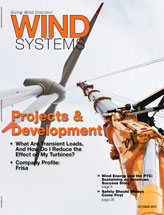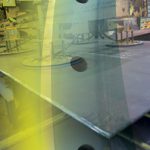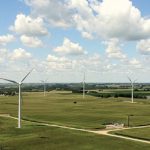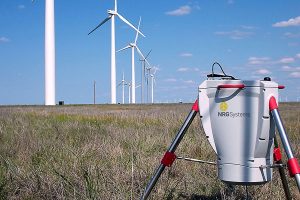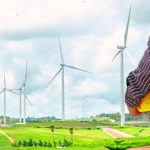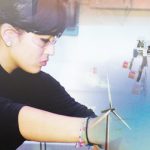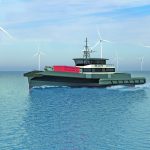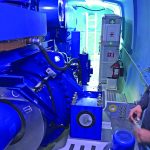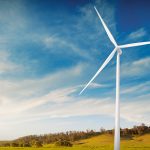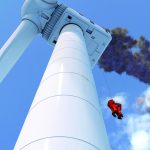The wind energy industry has made great strides to become a sound economic alternative to traditional power generation sources, and in an effort to become more cost competitive, the OEMs are developing larger turbines to harness more wind. This means taller towers, larger blades, and bigger drive trains. For a company like Frisa, these requirements mean the industry needs larger rings and shorter lead times.
Founded in Monterrey, Mexico, in 1971, Frisa started out as a steam hammer shop doing small forgings and supplying rings and blanks to local machine shops. Over time, the company expanded its capacities and diversified its product line in response to a growing global demand.
 For example, approximately 10 years after it began, the company purchased its first rolling mill, which was the catalyst it needed to enter the rolled ring market. In the 1990s, Frisa branched out from its main business in the oil and gas industry to diversify its end market. This led the company to look toward Europe, where the wind industry was a vital market in the renewable energy sector.
For example, approximately 10 years after it began, the company purchased its first rolling mill, which was the catalyst it needed to enter the rolled ring market. In the 1990s, Frisa branched out from its main business in the oil and gas industry to diversify its end market. This led the company to look toward Europe, where the wind industry was a vital market in the renewable energy sector.
“Oil and gas has always been an important business to us, but that industry typically requires smaller forgings,” said David Garcia, the business unit manager for Frisa’s wind division. “What we saw with wind was that larger rings were needed, and we realized this could give us the potential to get involved with large and extra-large rings.
In 2008, Frisa invested in the equipment needed to supply large rolled rings to the wind market. That same year, it opened another facility in the Monterrey area specifically for its wind operations. The Garcia facility’s campus hosts two operations — one for large rings and another for open die forging — on its 1,870,780 square feet of manufacturing space. Today, Frisa can manufacture rings up to 8 meters in diameter and up to 25 metric tons, and most of its wind customers are located throughout the U.S., Canada, Mexico, and Brazil.
The company has four manufacturing facilities in total; each one of them furnished with state-of-the-art equipment that enables Frisa to serve not only the wind and oil and gas industries, but also aerospace, power generation, construction, and mining markets, offering seamless rolled rings and open die forgings in an extensive range of carbon, alloy, and stainless steels, as well as titanium and superalloys.
According to Garcia, Frisa serves three markets within the wind industry, the first being bearings, which includes pitch and yaw slewing rings. The second market is the flanges for the towers, and, lastly, the gear market, meaning anything that goes inside a wind turbine’s gearbox, including rings, shafts, and spindles, as well as couplings to lock the flanges to the gearbox.
“All of our rings are absolutely 100-percent seamless rolled rings,” Garcia said. “While there are some uses for rings where you can use a straight bar, roll it into shape, and weld it, what we do is just a rolled ring. There’s no flash butt welding, so there’s no weak point that comes from welding. For some applications, welding is allowed, and for others you can’t because of the requirements, like in an engine or in bearings, where you can’t have a weak spot where the material would be welded together.”
 Seamless rolled rings require a forging process that directs the grain flow circumferentially and radially, giving the pieces the necessary mechanical properties to be more resistant to fatigue and impact. These rings can either be made from titanium and superalloys or carbon, alloy steel, and stainless steel.
Seamless rolled rings require a forging process that directs the grain flow circumferentially and radially, giving the pieces the necessary mechanical properties to be more resistant to fatigue and impact. These rings can either be made from titanium and superalloys or carbon, alloy steel, and stainless steel.
In addition to the seamless rolled rings, Frisa also manufactures contoured rolled rings. These differ from seamless rolled rings in that a contoured ring is a near-net-shape rolled ring.
Frisa’s near-net-shape rolled rings offer benefits associated with a forged material and provides the customer with savings in material and machining time that enable Frisa to become highly competitive. These rings can also be manufactured from titanium and superalloys or carbon, alloy steel, and stainless steel.
“With contoured rings, we’re giving the ring a profile achieving less input weight and better mechanical properties and behavior; this means that our customer has to machine less to get to the end design of the ring,” Garcia said.
Frisa’s rolled rings are used throughout the body of a wind turbine starting at the base and working their way up toward the middle of the tower and to the bases of the blades, as well as in the gearbox.
Additionally, Frisa’s open die capabilities are second to none. Its open die forging process is performed between flat dies with no precut profiles in the dies. These open die products include blocks, discs, hollows, bars, spindles, and step-down shafts. Frisa was also one of the first forging groups to be ISO-14001 certified.
Today, Frisa is a leading manufacturer of seamless rolled rings and open die forgings. It offers a wide range of carbon, alloy and stainless steels, titanium, and superalloys. Its world-class standards, strong commitment to quality, high level of customer service, and four state-of-the-art manufacturing facilities have made the company a reliable supplier among the world’s leading OEM customers.
Frisa’s mission to the wind power industry is to be the best option for its customers while offering high-value forging solutions and adapting to meet the specific needs of the wind energy market.
“We would like to think that a customer in the wind sector who has a large requirement with a complicated ring and challenging technical specification, would come to us because Frisa can best meet their needs. They turn to us for our expertise and technical know-how. They know that we will deliver on time and that they’re not going to run out of a product or have any issues once the rings are there.”
According to Garcia, one of Frisa’s top competitive advantages is its quick turnaround and short lead times.
 “Now more than ever, from the time you place a purchase order for a wind turbine to when you actually get it is a really short cycle time, and a big part of that is that we at Frisa are doing a great job with our short lead times,” Garcia said. “When you’re a link in a supply chain, everyone has to do their job to yield an optimal end result, and we believe we are doing that.”
“Now more than ever, from the time you place a purchase order for a wind turbine to when you actually get it is a really short cycle time, and a big part of that is that we at Frisa are doing a great job with our short lead times,” Garcia said. “When you’re a link in a supply chain, everyone has to do their job to yield an optimal end result, and we believe we are doing that.”
One example of how Frisa accomplished this occurred earlier this year when West Coast ports in the U.S. were at a standstill due to strike demonstrations put on by clerical workers, longshoremen, and truck drivers.
“It was challenging for our customers because they were depending on material like rings, flanges, and slewing rings when they suddenly had a backlog of ships that couldn’t be unloaded, which meant the products on the ships couldn’t be delivered to these customers,” Garcia said. “They have a transit time of about a month, but if you add that backlog, they were a couple months out of material because the rings were on the shore waiting to be unloaded and loaded on trucks to be delivered to the customers.
“As a result, customers were looking to us for a very quick turnaround, maybe a 6-week lead time or a 4-week lead time in some cases, just to substitute our product with the product they weren’t getting. We had great planning on our end. We had raw material in stock, and we had the flexibility to meet tight dates and keep our customers running and in business.”
Garcia said that this experience turned out to be a big learning opportunity for his team at Frisa and himself. Their customers gained a higher level of confidence in Frisa knowing it could meet the urgent needs of its customers in a timely manner without extending lead times as a reliable supplier.
“It helped us become more well-known across the U.S. as a domestic supplier,” Garcia said. “Although we’re located in Mexico, we’re only a truck shipment away.”
This is just one example of how Frisa is able to meet the challenging demands associated with the U.S. wind industry. Frisa plays an integral role in projects across the country within the chain of companies who work together to complete a wind farm, and it is doing its part in the process by providing high-quality seamless rolled rings in a timely, efficient manner.
“What’s important is that we guarantee the lifetime of our rings will be the same or better than the OEMs,” Garcia said. “In that regard, I hope our customers believe that we offer a great product that is going to last as long as the warranty is offered. We’ve been able to develop relationships with our customers and with the OEMs, and we will continue to invest in growing our operations.”
 According to Garcia, Frisa also has big plans for the future in terms of how it can best serve the wind industry, the most impressive of which is the development of a steel mill that should be up and running within the next year at its Monterrey location. This means Frisa will be able to supply its own steel to manufacture the rolled rings, and it will give the company that much more of a competitive advantage in terms of the flexibility to reduce cycle times and fill urgent orders.
According to Garcia, Frisa also has big plans for the future in terms of how it can best serve the wind industry, the most impressive of which is the development of a steel mill that should be up and running within the next year at its Monterrey location. This means Frisa will be able to supply its own steel to manufacture the rolled rings, and it will give the company that much more of a competitive advantage in terms of the flexibility to reduce cycle times and fill urgent orders.
Additionally, Garcia said that while Frisa mainly sells rings to the wind industry, because of its open die facility, it should be able to sell shafts, pinions, and other pieces in the next few years as well.
“This is an important development for the entire wind industry,” Garcia said. “Until now, they’ve had to rely on foreign suppliers. But now, at some point in the mid to short term, we’ll be able to deliver open die forgings, which would be a huge boost to our customers.”
With all of these developments and improvements in its facilities, Garcia said he believes that, like the wind industry, Frisa has never been more poised to serve its customers.
“I think that there’s a lot of room to grow,” Garcia said. “That’s what we’re looking forward to in the U.S., Canada, and Mexico and the rest of Latin America. Frisa has a lot of potential to keep growing our business and, consequentially, the wind industry.
“We are ready for the long haul, and we’ve done our homework in terms of investment and our relationships with important players in the United States. We’re standing side-by-side with the important guys, and we hope to keep it that way. The future should bring the industry good things.”
For more information, go to www.frisa.com.



















